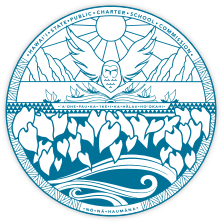The State Public Charter School Commission today formally presented its annual report to the State Board of Education. The report, the fourth by the Commission since its creation in 2012, covers the 2014-2015 school year and provides a wealth of information and data about the Hawaii’s chartering system and the performance of its 33 charter schools for that year.
The Commission is responsible for the authorizing and oversight of Hawaii’s charter schools, which operate as public schools under a three-year charter contract that includes academic, financial, and organizational performance measures. The annual report includes information on each school’s results, as well as on how charter schools are performing as a whole. “The 2014-2015 school year definitely was a challenging one for Hawaii’s charter sector,” said Commission Executive Director Tom Hutton, “but the people of Hawaii should know that their charter school system continues to make good progress.”
Among the highlights:
Academic
- As measured by the State’s Strive HI Performance System, in 2014-2015 four of Hawaii’s ten highest-performing public high schools were charter schools: Myron B. Thompson Academy (MBTA), University Laboratory School, Hawaii Academy of Arts & Science, and Ke Kula ‘o Samuel M. Kamakau. MBTA was the highest-performing public high school in the entire state.
- As measured by Strive HI, two of Hawaii’s ten highest-performing public middle schools were charter schools: Voyager: A Public Charter School (“Voyager”) and Innovations Public Charter School. Voyager was the highest-performing public middle school in the entire state.
- Six charter schools performed in the top 20 percent of their respective grade divisions under Strive HI, while ten schools were in the bottom 20 percent of their grade divisions.
- Over the past three years, collective charter school achievement in Reading/English Language Arts was approximately the same as the statewide averages for all public schools, slightly under statewide averages in Science, and somewhat under statewide averages in Math.
- Both high needs students (those qualifying for free and reduced lunch, special education students, and English Language learners) and non-high needs students in charter schools collectively achieved lower proficiency than the statewide averages for these two groups. The achievement gap between the two groups was about the same as in all public schools.
- Charter schools collectively outperformed statewide averages on the 8th grade ACT EXPLORE and 11th grade ACT exams, as well as their college-going rate. But they had a relatively lower overall high school graduation rate and a relatively higher overall rate of chronic absenteeism.
- Two charter schools that had been classified as “Focus” schools under Strive HI, West Hawaii Explorations Academy and Laupahoehoe Community Public Charter School, were able to exit Focus status as a result of their 2014-2015 performances. Voyager ascended to Strive HI’s highest classification, “Recognition,” the only non-elementary school in the entire state to do so.
- Under the Commission’s Academic Performance Framework (APF), which in some ways evaluates schools differently than does Strive HI, six schools earned higher scores than their Strive HI scores, seven earned the same, and 20 earned relatively lower scores. The highest-performing school as measured by the Commission’s APF was Ke Kula ‘o Samuel M. Kamakau, LCPS, which under the APF is evaluated partly using a school-specific measure of its own creation that was reviewed and approved by the Commission.
Financial
- Financial data show that charter schools generally are in fair financial positions, with slight deterioration on some indicators and improvement on others.
- For the most part the shorter-term financial indicators collectively improved or held steady from last year, but the longer-term indicators raise sustainability concerns if charter school funding does not continue to increase and/or schools are not able to realize more cost savings.
Organizational
- This year the Commission continued its intentionally incremental approach to organizational performance by focusing on key compliance priorities. Every charter school’s admissions policies and practices were reviewed, and many were revised by schools to ensure that they fulfill the fundamental promise of public education: open enrollment. Significant progress was made in ensuring that charter school teachers are in compliance with licensure requirements.
- Most charter schools did a good job at meeting their reporting and compliance responsibilities, and all schools complied with making key policies and procedures transparent online.
“Our charter school system continues to experience growing pains as we move forward together with the very difficult work of making sure our charter schools can reach their potential for public education in Hawaii,” said Commission Chairperson Catherine Payne. “This thorough report provides policymakers, parents, and the public a rich picture of the challenges but also of the real progress that is being made.”
The Commission also will deliver its annual report to the State Legislature. The report is available at this link or the Commission’s website, http://www.chartercommission.hawaii.gov, by clicking on “Information & Resources” and then “Reports.”

